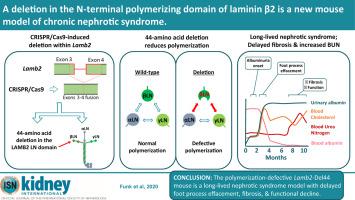Kidney International ( IF 19.6 ) Pub Date : 2020-02-20 , DOI: 10.1016/j.kint.2020.01.033 Steven D Funk 1 , Raymond H Bayer 1 , Karen K McKee 2 , Kazushi Okada 3 , Hiroshi Nishimune 3 , Peter D Yurchenco 2 , Jeffrey H Miner 1

|
The importance of the glomerular basement membrane (GBM) in glomerular filtration is underscored by the manifestations of Alport and Pierson syndromes, caused by defects in type IV collagen α3α4α5 and the laminin β2 chain, respectively. Lamb2 null mice, which model the most severe form of Pierson syndrome, exhibit proteinuria prior to podocyte foot process effacement and are therefore useful for studying GBM permselectivity. We hypothesize that some LAMB2 missense mutations that cause mild forms of Pierson syndrome induce GBM destabilization with delayed effects on podocytes. While generating a CRISPR/Cas9-mediated analogue of a human LAMB2 missense mutation in mice, we identified a 44-amino acid deletion (LAMB2-Del44) within the laminin N-terminal domain, a domain mediating laminin polymerization. Laminin heterotrimers containing LAMB2-Del44 exhibited a 90% reduction in polymerization in vitro that was partially rescued by type IV collagen and nidogen. Del44 mice showed albuminuria at 1.8-6.0 g/g creatinine (ACR) at one to two months, plateauing at an average 200 g/g ACR at 3.7 months, when GBM thickening and hallmarks of nephrotic syndrome were first observed. Despite the massive albuminuria, some Del44 mice survived for up to 15 months. Blood urea nitrogen was modestly elevated at seven-nine months. Eight to nine-month-old Del44 mice exhibited glomerulosclerosis and interstitial fibrosis. Similar to Lamb2−/− mice, proteinuria preceded foot process effacement. Foot processes were widened but not effaced at one-two months despite the high ACRs. At three months some individual foot processes were still observed amid widespread effacement. Thus, our chronic model of nephrotic syndrome may prove useful to study filtration mechanisms, long-term proteinuria with preserved kidney function, and to test therapeutics.
中文翻译:

层粘连蛋白β2 N-末端聚合结构域的缺失是慢性肾病综合征的新小鼠模型。
Alport 和 Pierson 综合征的表现突出了肾小球基底膜 (GBM) 在肾小球滤过中的重要性,这分别由 IV 型胶原蛋白 α3α4α5 和层粘连蛋白 β2 链的缺陷引起。模拟最严重的皮尔森综合征形式的Lamb2缺失小鼠在足细胞足突消失之前表现出蛋白尿,因此可用于研究 GBM 渗透选择性。我们假设一些导致轻度皮尔森综合征形式的LAMB2错义突变诱导 GBM 不稳定,并对足细胞产生延迟影响。在生成人类LAMB2的 CRISPR/Cas9 介导的类似物时在小鼠的错义突变中,我们在层粘连蛋白 N 末端结构域内发现了一个 44 个氨基酸缺失 (LAMB2-Del44),这是一个介导层粘连蛋白聚合的结构域。含有 LAMB2-Del44 的层粘连蛋白异源三聚体在体外聚合减少了 90% ,这部分被 IV 型胶原蛋白和巢蛋白挽救。Del44 小鼠在 1 到 2 个月时出现 1.8-6.0 g/g 肌酐 (ACR) 的白蛋白尿,在第 3.7 个月时达到平均 200 g/g ACR 的稳定水平,此时 GBM 增厚和肾病综合征的标志首次被观察到。尽管存在大量蛋白尿,但一些 Del44 小鼠存活了长达 15 个月。血尿素氮在七九个月时适度升高。8 到 9 个月大的 Del44 小鼠表现出肾小球硬化和间质纤维化。类似于Lamb2 -/-小鼠,蛋白尿先于足突消失。尽管 ACR 较高,足突在 1-2 个月时变宽但并未消失。三个月后,在广泛消失的情况下,仍然可以观察到一些单独的足部突起。因此,我们的肾病综合征慢性模型可能对研究滤过机制、保留肾功能的长期蛋白尿和测试治疗方法有用。



























 京公网安备 11010802027423号
京公网安备 11010802027423号